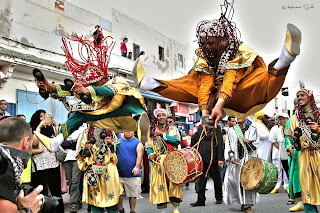Travel To Morocco For the Gnaoua (Gnawa) Festival in Essaouira
The mysterious music of the Gnaouas is celebrated each year at the Gnaoua Festival in Essaouira.
Essaouira is an Atlantic seaside resort town and has long been considered as one of the best anchorages of the Moroccan coast. The Medina of Essaouira (formerly "Mogador") is a UNESCO World Heritage listed city, as an example of a late 18th century fortified town.
 |
| Gnaoua Festival in Essaouira |
The Gnaoua Festival attracts a cosmopolitan audience of 500,000 festival-goers annually and offers a rich program, reaffirming its goal to emphasize the Gnaoua heritage in all its variety and to invite the best world and jazz artists to come and perform in the unique and magical town of Essaouira.
This popular four day festival features art exhibitions and Gnaoua style music. International musicians and groups from Tangier, Marrakesh, and Essaouira perform their Gnaoua sounds at the Place Moulay Hassan and other spaces in the medina and outside its city walls such as Bab Doukkala, Bab Marrakech, Dar Souiri, Chez Kebin, Zaouia Gnaoua, Place Khayma and the Marche Aux Grain.
This popular four day festival features art exhibitions and Gnaoua style music. International musicians and groups from Tangier, Marrakesh, and Essaouira perform their Gnaoua sounds at the Place Moulay Hassan and other spaces in the medina and outside its city walls such as Bab Doukkala, Bab Marrakech, Dar Souiri, Chez Kebin, Zaouia Gnaoua, Place Khayma and the Marche Aux Grain.
 The festival recently honored the Gnaoua musicians with a new stage, which is dedicated to them at Bab Doukkala, allowing the ardent supporters of the Gnaoua rhythms to meet with the stars, from Hamid El Kasri to Abdelkébir Merchane. This stage was created for 100 % Gnaoua concerts, as well as the traditional lilas in the exceptional Gnaoua Zaouia (trance performances) every evening at midnight for the purists.
The festival recently honored the Gnaoua musicians with a new stage, which is dedicated to them at Bab Doukkala, allowing the ardent supporters of the Gnaoua rhythms to meet with the stars, from Hamid El Kasri to Abdelkébir Merchane. This stage was created for 100 % Gnaoua concerts, as well as the traditional lilas in the exceptional Gnaoua Zaouia (trance performances) every evening at midnight for the purists.
World and jazz musicians perform on the new stage Bab Sebaa and The Moulay Hassan stage is kept for the famous groups of very diverse styles. On the smaller stages in the medina, the new generation of maâlems performs, and fans of electronic fusion and contemporary Moroccan music now have two new dedicated areas: the Pepsi stage and the Méditel stage.
The Gnaoua Festival offers 10 concert sites from which everyone can choose according to their taste, 10 different but complementary programs forming the details of a unique puzzle, that of a pioneering and cosmopolitan festival. The quality is excellent as ever.
Each evening is usually broken down into a few parts. In the first part, the Gnaoua musicians perform between six and nine pm. The favorite of many is when Maâlem (Master) Gnaoua and their bands begin to play, around the eleven pm. The Maâlems have venerable stringed-instrument traditions involving both bowed lutes like the gogo and plucked lutes like the gimbri, also called hajhuj a three-stringed bass instrument.
The hajhouj, a guitar like instrument made of camel's leather. Its strings come from the roots of trees combined with dried, twisted sheep or goat colons. The hajhouj gives Gnaoua music its distinctive bass sounds. Gnaoua hajhuj players use a technique which 19th century American minstrel banjo instruction manuals identify as "brushless drop-thumb frailing". The "brushless" part means the fingers do not brush several strings at once to make chords. Instead, the thumb drops repeatedly in a hypnotically rhythmic pattern against the freely-vibrating bass string producing a throbbing drone, while the first two or three fingers of the same (right) hand pick out, often percussive patterns in a drum-like, almost telegraphic manner. The Gnawa hajhuj has strong historical and musical links to West African lutes like the Hausa halam, a direct ancestor of the banjo. The Gnawa also use large drums called the ganga or tbel and krakebs large iron castanets in their ritual music.
The message is usually something spiritual or religious that has the power to heal. At one point in the songs, an instrument making “krakeb” sounds places the audience into a trance as both musicians and the audience begin to sway.
After the Maâlem, between 12am and 2am in the morning, there is a fusion of sounds between the spiritual Gnaoua music and the multi-cultural sounds of non-Gnaoua jazz musicians playing European, American, Rock, and African Blues. The late morning concerts are a fusion between these artists.
Gnaoua music combines music and acrobatic dancing. Gnaoua music is both a prayer and a celebration of life.
 |
| music and acrobatic dancing |
In a Gnaoua song, similar to American pop music, one phrase or a few lines are repeated consistently regardless of how short or long the song may be; although most are quite long surpassing twenty minutes. In fact, a song may last up to several hours non-stop. To many who are unfamiliar with the Gnaoua, their performances may appear to be one long song when actually they are a series of spiritual chants.
The Gnaoua Festival of Essaouira has changed the face of the original Gnaoua ritual music by fusing its core spiritual music with similar genres like jazz, blues, reggae and hip-hop. The famous musicians that participate each year exchange and mix their own music with Gnaoua music, creating one of the largest public festivals in Morocco as well as one of the best and most exciting jam sessions.





